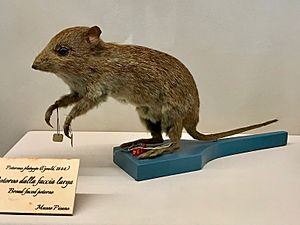Broad-faced potoroo facts for kids
Quick facts for kids Broad-faced potorooTemporal range: Recent
|
|
|---|---|
 |
|
| Stuffed specimen at the Natural History Museum Pisa | |
| Conservation status | |
| Scientific classification |
The Broad-faced potoroo (Potorous platyops) was a small marsupial from southwestern Australia. It is now extinct. This animal was a type of potoroo, which are like small kangaroos.
Scientists first found a broad-faced potoroo in 1839. John Gould, a famous naturalist, described it in 1844. Very few of these animals were ever seen alive after that. The last one was caught in 1875. Old bones and sub-fossil remains show that it once lived across a wide area. This included the dry coastal parts of Southwest Australia.
We don't know much about where the broad-faced potoroo lived. Unlike its relatives, like the Long-nosed potoroo or Long-footed potoroo, it probably didn't live in thick forest undergrowth. Preserved specimens tell us it was smaller than other potoroos. It was about 300 millimetres (12 inches) long, with a tail of about 180 millimetres (7 inches). It weighed around 800 grams (1.7 pounds). Its fur was yellowish-brown on top and greyish-white underneath. It had a body shape similar to other potoroos. Its ears were small and round, its nose was short, and its cheeks looked puffy.
Contents
Discovering the Broad-faced Potoroo
The first scientific description of the broad-faced potoroo came from John Gould. He used a specimen found by his collector, John Gilbert. Gilbert found it near "Walyema Swamps" in Western Australia. This area is now known as Lake Walyormouring. Gilbert was collecting animals around the new Swan River Colony.
The first specimen was sent to the Linnean Society of London. The partial skull and skin of a female are now kept at the British Museum of Natural History. Not many more specimens were collected after Gould's first description.
- In the 1840s, James Drummond collected one animal.
- In the 1860s, George Masters collected four specimens near Mordup.
- The last broad-faced potoroos seen alive were collected in 1874 by William Webb. These are now at the Macleay Museum in Sydney.
Later, a scientist named Hedley H. Finlayson found some bones in a cave in South Australia. These bones looked like the broad-faced potoroo. However, they were found far from where the animal was thought to live. Also, the teeth looked a bit different. Finlayson first thought it was a new species and named it potorous morgani. But later, it was confirmed to be the broad-faced potoroo. The name morgani was given to honor the collector, A.M. Morgan.
People had different names for this animal. The Nyungar people called it moda or mort. Early European settlers also called it the broad-faced rat kangaroo.
What Did It Look Like?

The broad-faced potoroo was part of the Potorous group. It had a skull that was wider than other potoroos. Its nose was also shorter.
The broad-faced potoroo likely became extinct sometime after 1875. This was the last time a live one was seen. It was probably gone by 1905.
Its fur was greyish-brown on its back. It had straw-yellow hairs mixed in, giving it a streaked look. Its belly and sides were pale grey. The head and body were about 305 millimetres (12 inches) long. Its tail was about 178 millimetres (7 inches) long. Its hind feet were about 54 millimetres (2 inches) long. It weighed around 800 grams (1.7 pounds). Its short, blunt nose was unusual for a potoroo. This type of nose is more common in animals like the Rufous rat-kangaroo and the desert rat-kangaroo.
Life and Disappearance
We don't know much about how the broad-faced potoroo lived. We also don't know what it ate. One early report from John Gilbert's helpers said it was found "in a thicket surrounding one of the salt lagoons in the interior." This suggests it lived near salty wetlands.
Some historical records suggest that a "disease" might have affected the potoroo population. This disease was similar to one that caused other animal species to disappear suddenly. It's possible an epizootic (an animal disease outbreak) in the 1890s led to their extinction.
A collector named Guy C. Shortridge searched for this species in 1910. He found skulls of Gilbert's potoroo in caves near Margaret River. But he could only find old stories about the broad-faced potoroo. He reported that Nyungar people told him the species became extinct in 1905. They said it was once common and similar to the quokka in where it lived and its habits.
Bones of the broad-faced potoroo have been found in different places. Some were found under a moving sand dune. Others were found in an old midden (a pile of waste) under a large peppermint tree. This midden also contained bones of animals introduced by Europeans, meaning it was from recent times. Bones identified as broad-faced potoroo were also found on the Eyre Peninsula. These might have been middens from early Aboriginal peoples.
Where It Lived
The few times live broad-faced potoroos were recorded were all in Southwest Australia. It's possible the species was already close to extinction when the first specimen was found. We don't know exact locations with certainty.
However, sub-fossil remains show that it once lived across a much wider area. This included southern and western Australia, like the Nullarbor Plain. It might have even lived as far north as the Northwest Cape region. Bones have also been found on Kangaroo Island.
There is some evidence that the broad-faced potoroo was already declining. This happened even before the European rabbit spread into its habitat. The rabbits were an invasive species that competed with native animals.
See also
 In Spanish: Potoroo de cara ancha para niños
In Spanish: Potoroo de cara ancha para niños


